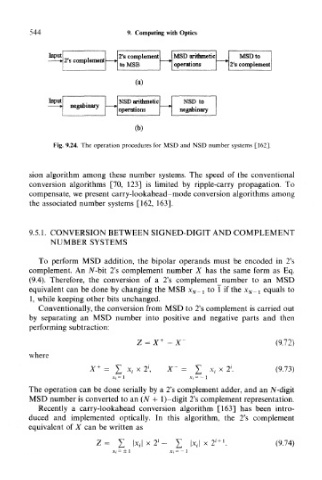Page 559 - Introduction to Information Optics
P. 559
544 9. Computing with Optics
(a)
Input NSD arithmetic NSD to
negabinary — »• — »•
operations negabinary
(b)
Fig. 9.24. The operation procedures for MSD and NSD number systems [162].
sion algorithm among these number systems. The speed of the conventional
conversion algorithms [70, 123] is limited by ripple-carry propagation. To
compensate, we present carry-lookahead-mode conversion algorithms among
the associated number systems [162, 163].
9.5.1. CONVERSION BETWEEN SIGNED-DIGIT AND COMPLEMENT
NUMBER SYSTEMS
To perform MSD addition, the bipolar operands must be encoded in 2's
complement. An JV-bit 2's complement number X has the same form as Eq.
(9.4). Therefore, the conversion of a 2's complement number to an MSD
equivalent can be done by changing the MSB X N_ v to I if the x N^ l equals to
1, while keeping other bits unchanged.
Conventionally, the conversion from MSD to 2's complement is carried out
by separating an MSD number into positive and negative parts and then
performing subtraction:
y+
</\ (9,72)
where
+
1
X = £ x,. x 2', X~ = £ x,. x 2 '. (9.73)
Xi = 1 Xi = - I
The operation can be done serially by a 2's complement adder, and an IV-digit
MSD number is converted to an (N + 1)-digit 2's complement representation.
Recently a carry-lookahead conversion algorithm [163] has been intro-
duced and implemented optically. In this algorithm, the 2's complement
equivalent of X can be written as
x, x 2' - (9.74)

